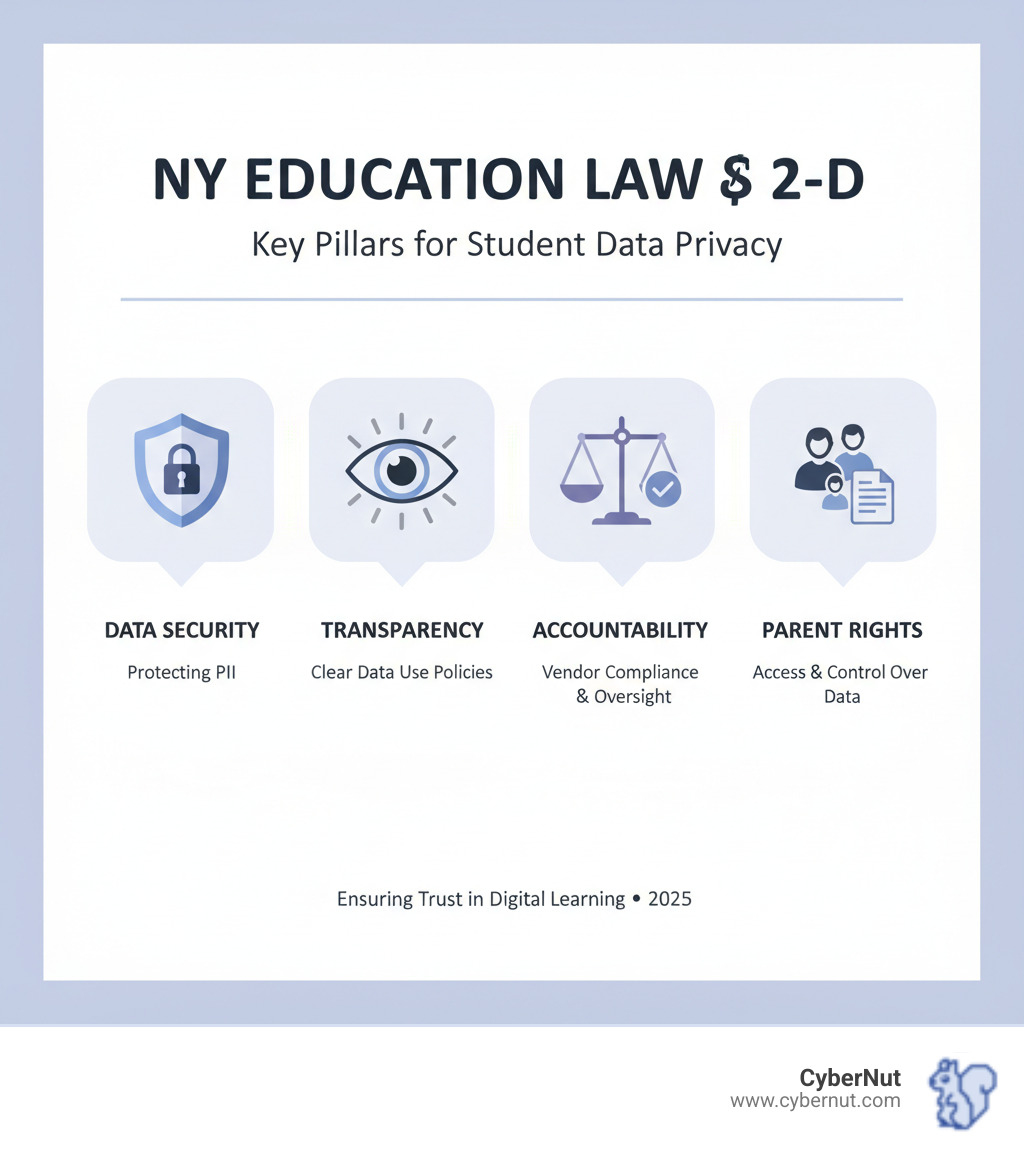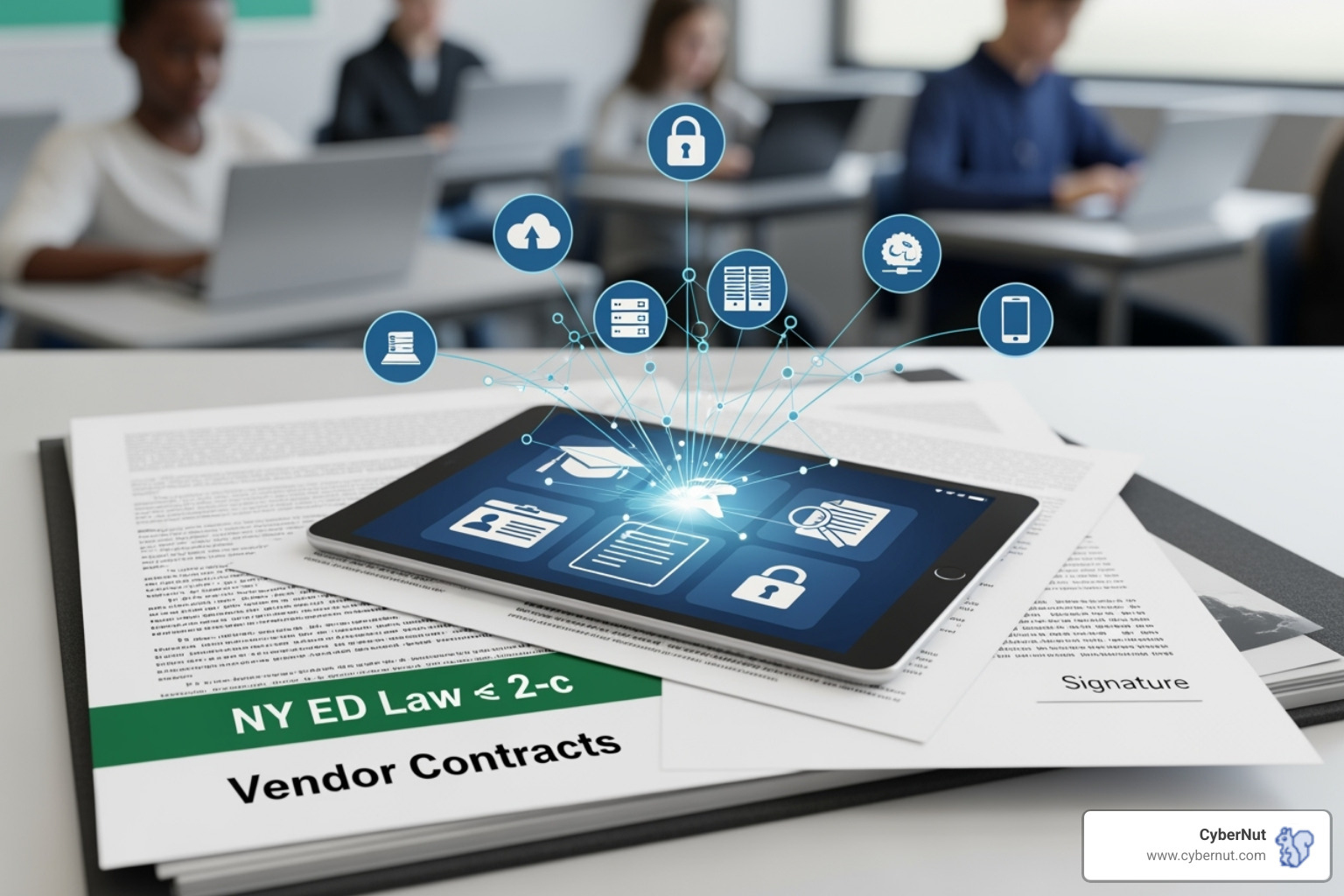
Oliver Page
Case study
October 3, 2025

If you're looking for What to Know About NY Education Law § 2-c: Vendor Contracts and Student Data Use, it's crucial to know that the primary law governing this area is actually NY Education Law § 2-d. This law sets strict rules for protecting the sensitive information of students, teachers, and principals when working with third-party vendors.
Here's a quick overview of NY Education Law § 2-d:
As schools increasingly rely on technology, student data frequently moves between school systems and third-party vendors. NY Education Law § 2-d ensures privacy is a priority, building trust among administrators, EdTech companies, and families. This guide will walk K-12 IT Directors through the specifics of meeting these vital requirements.

What to Know About NY Education Law § 2-c: Vendor Contracts and Student Data Use word roundup:
Even if you're looking for What to Know About NY Education Law § 2-c: Vendor Contracts and Student Data Use, understanding NY Education Law § 2-d is essential. It's the primary rulebook for student data privacy in New York, created to address the risks that come with increased technology use in schools.

This law builds trust by ensuring schools, parents, and EdTech vendors handle data responsibly. It addresses how student data is collected, stored, and shared. For a deeper dive, see our full guide: All About New York's Education Law 2-D: Student Data Privacy Explained.
The main goal of NY Education Law § 2-d is to secure the Personally Identifiable Information (PII) of students, teachers, and principals. It provides firm rules for how schools and their vendors collect, store, and use this sensitive data.
Think of it as a digital shield for your school's data. The law ensures that sensitive information is used only for legitimate educational purposes, promoting transparency and accountability. It's a major step toward strengthening privacy in digital classrooms. You can read the full text of the law here: New York State Education Law 2-d.
NY Education Law § 2-d protects several types of sensitive information:
This law aims to prevent unauthorized sharing or misuse of this data, whether it's stored on a school server or with a third-party vendor. Other laws, like the NY SHIELD Act, add further layers of security. Learn more in our article: What to Know About the NY SHIELD Act and Its Impact on School Cybersecurity.
A key component of § 2-d is the Parents' Bill of Rights for Data Privacy and Security, which every school must publish. This document gives parents and guardians clear rights regarding their child's data.
Key parental rights include:
This Bill of Rights is a public commitment to transparency and accountability, empowering families to participate in protecting their children's digital lives. For more public data information, visit the Public Data section of the NYSED website.
While the keyword for this article is What to Know About NY Education Law § 2-c: Vendor Contracts and Student Data Use, the specific requirements for vendor contracts are detailed in NY Education Law § 2-d. This section focuses on the mandates of § 2-d for educational agencies and their third-party vendors.

Schools partner with numerous EdTech vendors, creating data management challenges. NY Education Law § 2-d provides a framework for these partnerships through contractual obligations, the appointment of a Data Protection Officer (DPO), and adherence to the NIST Cybersecurity Framework. For a broader look at this topic, see our guide on Cybersecurity for Educational Institutions.
NY Education Law § 2-d sets strict rules for vendors accessing student, teacher, or principal data. Vendors must actively follow specific data privacy and security standards.
Key vendor requirements include:
Meeting these requirements involves a comprehensive data security plan. Learn more in our article, Beyond Firewalls: How to Secure Data Shared with Third-Party EdTech Vendors.
Schools also have significant responsibilities under § 2-d to act as guardians of sensitive information.
School obligations include:
These duties require careful management and oversight. For more on data handling, visit our Data Processing page.
Under § 2-d, certain clauses are legally required in any vendor agreement involving student, teacher, or principal data.
Must-have clauses include:
These clauses transform a service agreement into a robust data protection agreement. For more details, read our post: Contract Clauses Every School Should Demand in EdTech Agreements.
Schools are required to adopt the National Institute of Standards and Technology’s Cybersecurity Framework (NIST CSF). This framework provides a standardized, risk-based approach to managing cybersecurity.
NIST CSF is organized around five core functions:
For schools, adopting NIST CSF means moving to a recognized security standard, systematically managing risks, and having a common framework to verify vendor compliance. It provides the "how-to" for achieving the data security goals that § 2-d demands, helping schools and vendors build strong defenses against cyber threats.
Complying with NY Education Law § 2-d is about actively protecting sensitive school data. But what happens when rules are broken or a data breach occurs? This section covers the impact of non-compliance and the necessary steps for responding to a data privacy compromise.

A data breach involving student data can have lasting consequences. For more on this topic, read our article, Third-Party Data Breaches 101.
How does NY Education Law § 2-d compare to the federal Family Educational Rights and Privacy Act (FERPA)?
FERPA (Federal Law): This is the foundational federal law protecting the privacy of student education records nationwide. It gives parents rights to access, amend, and control the disclosure of their child's records. It applies to all schools receiving federal funding but is less specific about cybersecurity. For federal guidance, see the USDOE Guidance for LEAs Administering College Admissions Exams.
NY Education Law § 2-d (State Law): This law is New York's more detailed, tech-focused response to modern data privacy challenges. It goes beyond FERPA, especially regarding vendor contracts and cybersecurity.
Key differences:
In New York, schools must comply with both laws, adhering to the stricter rule where they overlap.
Failing to comply with NY Education Law § 2-d carries significant consequences for both schools and vendors.
Potential repercussions include:
The message is clear: proactive compliance is a crucial shield against serious legal and reputational harm.
In the event of a data breach, § 2-d outlines clear notification procedures to ensure transparency and allow affected individuals to protect themselves.
The process includes:
Effective breach notification is about maintaining trust and demonstrating a commitment to privacy. For more on data protection, visit our Privacy page.
Understanding the real-world impact of NY Education Law § 2-d is key. Here are answers to some common questions about this important legislation.
NY Education Law § 2-d requires transparency, making it easy for parents to find out which vendors handle their child's data. The best place to look is your local school district's official website. Schools must publish their Data Privacy and Security Policy, the Parents' Bill of Rights, and a list of all third-party contractors with access to student data.
For each vendor, schools must also post "Supplemental Information" detailing the vendor's name, the purpose of the contract, the types of data shared, and how that data is protected. Your school's Data Protection Officer (DPO) is another excellent resource for any questions about data privacy and vendor relationships.
Verifying vendor compliance is a critical, ongoing responsibility for schools under § 2-d, typically managed by the Data Protection Officer (DPO).
Key verification methods include:
This multi-faceted approach ensures schools are actively verifying compliance, not just hoping for it.
New educational technology (EdTech) offers great learning opportunities but also presents privacy challenges under § 2-d. Schools must approach new tools with careful consideration.
Key implications include:
Some technologies, like biometrics, have prompted specific laws, such as New York's biometric ban in K-12 schools. Learn more in our article: New York's Biometric Ban: What Schools Need to Know About the 2021 K-12 Data Law. Adopting new EdTech requires a proactive and diligent approach to protecting student data.
Our exploration of What to Know About NY Education Law § 2-c: Vendor Contracts and Student Data Use has shown that the core requirements are found in the comprehensive framework of NY Education Law § 2-d. This legislation is the key to protecting student, teacher, and principal data in New York's schools.
Compliance with § 2-d is about more than just following rules; it's about building trust with families and protecting the students in your care. We've covered the law's key components, from the Parents' Bill of Rights and vendor requirements to the NIST Cybersecurity Framework and breach notification procedures.
The message is clear: proactive compliance is not optional. It is the foundation of a strong cybersecurity culture. This requires vigilant vendor vetting, continuous staff training, and a dedicated Data Protection Officer who champions privacy. Data security must be an ongoing commitment, not a checkbox exercise.
However, even the best policies can't stop every threat. The human element is often the weakest link. A single click on a phishing email can bypass security measures, leading to the very data breaches § 2-d aims to prevent.
That's where CyberNut can help. We understand the unique cybersecurity challenges K-12 schools face. Our custom training transforms your staff into a human firewall through engaging, gamified micro-trainings that focus on phishing awareness. Our approach is designed for educational institutions—low-touch, effective, and custom to your needs.
Think your staff can spot today's sophisticated phishing attempts? It's time to find out. Get your free phishing audit today and find where your vulnerabilities lie. There's no obligation, just valuable insights to help protect your school community.
Building a culture of cybersecurity means combining strong policies with empowered people. It means meeting the requirements of Education Law § 2-d while preparing your staff for real-world threats. To learn more about how CyberNut can support your school, explore our cybersecurity resources and let's build a safer digital learning environment together.

Oliver Page

Some more Insigths


Back